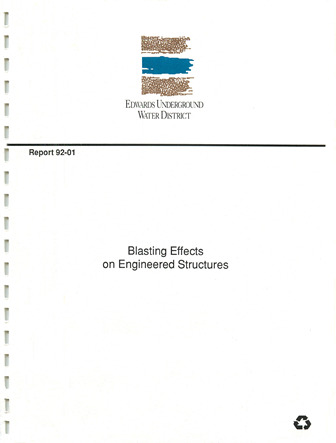Blasting Effects on Engineered Structures

| Author | University of Texas at San Antonio Center for Water Research |
| Year | 1992 |
| Description | Report of field study on effects of blasting charges on structure and function of nearby pipes, wells, and tanks. See accompanying appendices. |
| Report Number | 92-01 |
| Publisher | Edwards Underground Water District |
| Location | Edwards Aquifer, Balcones Fault Zone, San Antonio Segment, Recharge Zone, Bexar County |
| Cover | View Download |
| File | View Download |
| Summary |
|
The investigation of the effects of blasting was commissioned by the Edwards Underground Water District (EUWD) to determine how blasting degrades the integrity of underground structures and what criteria might be effective to limit facility degradation. The study successfully achieved both objectives, and the major findings are as follows:
(1) None of the structure types investigated in the field (wells, pipes and tanks) suffered damage causing loss of their contents or loss of function when production charges were detonated at distance greater or equal to 10 feet. All of the structures in the study were in good condition and installed according to city and state specifications. More conservative criteria should be applied to structures and systems that have not been constructed according to specifications and/or have become more fragile with age. Also, the total size of the blast and the delay sequence must be considered. (2) Well-behaved relationships between the amplitude of blast response at a given location and the size of the energy source (velocity response ratio, VRR) were obtained. These relationships indicate that the vibration response to production blasting at selected locations may be predicted with reasonable accuracy from the measured site response to small (calibration) blasts.
(3) Variations of blast response amplitude with depth (normalized velocity response, NVR) for the target structures were also well behaved. In general, amplitude decreases with depth. When the charge is detonated close to the structure, the amplitude may be relatively constant with depth, or may increase with depth for large, close events. The longitudinal (radial) component of motion is most likely to display the latter behavior, probably due to improved energy transmission in saturated ground. (4) The relationships between source energy and response amplitude, and the relationships between amplitude and depth may be combined in a response prediction procedure. First the site response to a small charge (e.g. 1/2 lb. of dynamite) is measured at points of interest. Next the ground surface response to a production blast is determined from the low-energy response and the energy/amplitude relationship, VRR. Finally the subsurface response in and around the structure is predicted from the surface response and the relationship between amplitude and depth, NVR. Details of the development and application of the procedure are given in section 7 of the report. The prediction techniques developed in the study show promise for application to vibration control during production blasting. Application of the method in construction will provide an opportunity to collect a reservoir of data which can be used to improve the accuracy and precision of site response predictions. Reducing uncertainty in blast operations will help the excavation contractor to complete his job more safely and efficiently, and will reduce the risk of aquifer contamination by limiting damage to underground structures. The investigators acknowledge the generous support of the Edwards Underground Water District for the work completed under this contract, and look forward to providing future assistance to the District in the development of solutions to related technical problems. |
Search for Documents
Advance Search
Explore EAA's Scientific Reports
- All Reports
- Water Resources Planning and Management
- Floods and Drought
- Water Quality
- Climatology
- Surface Water / Groundwater Relationship
- Biology
- Springs, Groundwater Discharge
- Archaeology
- RZ Protection
- Aquifer Levels
- Remote Sensing
- Precipitation
- Overview Studies
- Modeling
- Hydrology and Hydrogeology
- History
- Groundwater Recharge, Recharge Zone
- Groundwater Movement
- Geomorphology and Caves
- Weather Modification
- Geology
- Water Use and Conservation
- Geochemistry
